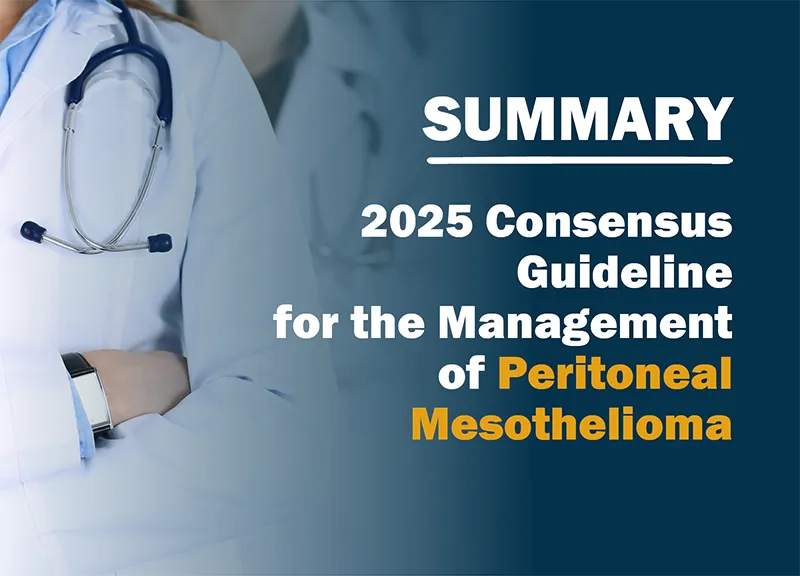Summary of the 2025 consensus guideline for the management of peritoneal mesothelioma

It is estimated that approximately 3,000 people are diagnosed with mesothelioma each year in the United States. Compared with roughly 230,000 diagnoses of lung cancer, mesothelioma is a very rare cancer. Pleural mesothelioma, which is mesothelioma of the lining of the lung, is by far the most commonly occurring variety of this cancer. Peritoneal mesothelioma, which is mesothelioma that affects the lining of the abdominal cavity, sees 300-400 new diagnoses each year in the United States. For this reason, randomized clinical trials for peritoneal mesothelioma are not feasible. However, despite a lack of approved standard treatment for this type of mesothelioma, experts have come together to identify areas of consensus in what constitutes the best practices in treatment of peritoneal mesothelioma. This compilation of guidelines is an update on a previous iteration from 2018.
The manuscript by Brown LM, Wilkins SG, Bansal VV, Su DG, Gomez-Mayorga J, Turaga KK, Gunderson CG, Lee B, Nash GM, Hays JL, Raghav KP, Husain AL, Kluger MD, Zauderer MG, Kindler HL, Alexander HR; Peritoneal Surface Malignancies (PSM) Consortium Group. Consensus Guideline for the Management of Peritoneal Mesothelioma https://brand.msu.edu/Downloads. Ann Surg Oncol. 2025 Jun 25. doi: 10.1245/s10434-025-17358-x. Epub ahead of print. PMID: 40560500, was published in June of 2025.
The collection of these guidelines was made possible by ongoing research efforts, which include clinical trials. As the authors eloquently state:
“Clinical trial enrollment should be considered at every step of treatment, not only to expand our knowledge of this rare disease but also to enhance patient care opportunities.”
Major updates
- This iteration of treatment guidelines for peritoneal mesothelioma emphasizes the importance of a multi-disciplinary approach, particularly in a pre-operative setting.
- Additionally, psychosocial interventions should be incorporated as part of patient care throughout treatment and after.
- For benign pathologies such as peritoneal inclusion cysts and well-differentiated papillary mesothelial tumors, the new best practice is to observe while reserving surgical resection for patients with symptomatic, recurrent, diffuse, or microinvasive disease. Imaging surveillance type and specific treatment should be based on risk stratification.
2025 Consensus Guidelines for clinicians and patients navigating PeM diagnosis, treatment, and follow-up.
Diagnosis & Initial Assessment
-
Multidisciplinary Evaluation
- Engage surgical oncology, medical oncology, radiology, pathology, and social work.
-
Imaging
- CT or MRI of abdomen/pelvis with contrast.
- CT chest to check for spread.
- PET scan: optional in select cases.
-
Biopsy
- Prefer laparoscopic biopsy to assess tumor extent.
- Avoid cytology alone (often inadequate).
-
Pathology & Biomarkers
- Determine histologic subtype: epithelioid, biphasic, sarcomatoid.
- Test for Ki-67, PD-L1, ALK.
- Tumor somatic sequencing is not currently part of the protocol. Additional research is needed to determine clinical usefulness.
Benign or Borderline Disease
-
Asymptomatic, Localized Disease (e.g., WDPMT)
- Observation with imaging every 6 months.
-
Symptomatic or Progressive Disease
- Consider surgical resection.
- Repeat biopsy to rule out malignancy.
- Systemic therapy not routinely recommended.
Malignant Peritoneal Mesothelioma (PeM) Management
Risk Stratification:
- Low-Risk:
- Resectable disease.
- Favorable histology (epithelioid), younger age, good performance status.
- Treatment: Upfront CRS + IPCT.
- Intermediate-Risk:
- Larger tumor burden or borderline operability.
- Treatment: Neoadjuvant chemotherapy or immunotherapy, then reassess for surgery.
- High-Risk:
- Unresectable, poor performance status, aggressive histology.
- Treatment: Systemic therapy only (chemo or immunotherapy).
Systemic Therapy Options
- Epithelioid:
- First-Line: Pemetrexed + cisplatin/carboplatin ± bevacizumab OR nivolumab + ipilimumab.
- Second-Line: Switch to the other class (e.g., ICI if chemo first).
- Biphasic/Sarcomatoid:
- First-Line: Nivolumab + ipilimumab.
- Consider chemo if ICI is ineffective or not tolerated.
- Note: Clinical trial participation is encouraged at all stages.
Surgical Principles (CRS + IPCT)
- Goal: Complete cytoreduction (CC-0 or CC-1).
- May require resection of multiple abdominal organs.
- Requires expert surgical team.
- Consider palliative debulking in select cases.
Surveillance Protocol
- Benign Disease:
- CT/MRI every 6 months (first 2 years), then annually.
- Post-Treatment PeM:
- Every 3 months (years 1-2),
- Every 6 months (years 3-4),
- Annually thereafter.
Patient Support & Quality of Life
- Early referral to palliative care.
- Access to peer support and survivorship resources.
- Consider mental health and rehab services.
Conclusion
Management of PeM is highly individualized, requiring a multidisciplinary team and frequent reassessment. The consensus guideline promotes evidence-informed care and supports ongoing research to optimize treatment and survivorship outcomes.
Free Mesothelioma Patient & Treatment Guide
We’d like to offer you our in-depth guide, “A Patient’s Guide to Mesothelioma,” absolutely free of charge.
It contains a wealth of information and resources to help you better understand the condition, choose (and afford) appropriate treatment, and exercise your legal right to compensation.
Download Now